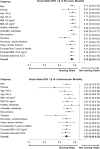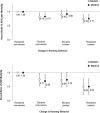Leisure-time running reduces all-cause and cardiovascular mortality risk
- PMID: 25082581
- PMCID: PMC4131752
- DOI: 10.1016/j.jacc.2014.04.058
Leisure-time running reduces all-cause and cardiovascular mortality risk
Erratum in
- J Am Coll Cardiol. 2014 Oct 7;64(14):1537
Abstract
Background: Although running is a popular leisure-time physical activity, little is known about the long-term effects of running on mortality. The dose-response relations between running, as well as the change in running behaviors over time, and mortality remain uncertain.
Objectives: We examined the associations of running with all-cause and cardiovascular mortality risks in 55,137 adults, 18 to 100 years of age (mean age 44 years).
Methods: Running was assessed on a medical history questionnaire by leisure-time activity.
Results: During a mean follow-up of 15 years, 3,413 all-cause and 1,217 cardiovascular deaths occurred. Approximately 24% of adults participated in running in this population. Compared with nonrunners, runners had 30% and 45% lower adjusted risks of all-cause and cardiovascular mortality, respectively, with a 3-year life expectancy benefit. In dose-response analyses, the mortality benefits in runners were similar across quintiles of running time, distance, frequency, amount, and speed, compared with nonrunners. Weekly running even <51 min, <6 miles, 1 to 2 times, <506 metabolic equivalent-minutes, or <6 miles/h was sufficient to reduce risk of mortality, compared with not running. In the analyses of change in running behaviors and mortality, persistent runners had the most significant benefits, with 29% and 50% lower risks of all-cause and cardiovascular mortality, respectively, compared with never-runners.
Conclusions: Running, even 5 to 10 min/day and at slow speeds <6 miles/h, is associated with markedly reduced risks of death from all causes and cardiovascular disease. This study may motivate healthy but sedentary individuals to begin and continue running for substantial and attainable mortality benefits.
Keywords: all-cause mortality; cardiovascular mortality; dose response; epidemiology; physical exercise; running pattern.
Copyright © 2014 American College of Cardiology Foundation. Published by Elsevier Inc. All rights reserved.
Figures





Comment in
-
Minimal amount of exercise to prolong life: to walk, to run, or just mix it up?J Am Coll Cardiol. 2014 Aug 5;64(5):482-4. doi: 10.1016/j.jacc.2014.05.026. J Am Coll Cardiol. 2014. PMID: 25082582 No abstract available.
-
"Add 10 min for your health": the new Japanese recommendation for physical activity based on dose-response analysis.J Am Coll Cardiol. 2015 Mar 24;65(11):1153-4. doi: 10.1016/j.jacc.2014.10.080. J Am Coll Cardiol. 2015. PMID: 25790890 No abstract available.
-
Reply: "add 10 min for your health": the new Japanese recommendation for physical activity based on dose-response analysis.J Am Coll Cardiol. 2015 Mar 24;65(11):1154-5. doi: 10.1016/j.jacc.2014.11.066. J Am Coll Cardiol. 2015. PMID: 25790891 No abstract available.
References
-
- Lamppa R. 2011 Marathon, half-marathon and state of the sport reports. 2011 http://www.runningusa.org/statistics. Accessed December 1, 2013.
-
- World Health Organization Global Recommendations on Physical Activity for Health. 2010 http://www.who.int/dietphysicalactivity/factsheet_recommendations/en/ind.... Accessed December 1, 2013. - PubMed
-
- US Department of Health and Human Services 2008 Physical Activity Guidelines for Americans. 2008 http://health.gov/PAGuidelines. Accessed December 1, 2013.
-
- Physical Activity Guidelines Advisory Committee Physical Activity Guidelines Advisory Committee Report. 2008 http://health.gov/PAGuidelines. Accessed December 1, 2013.
Publication types
MeSH terms
Grants and funding
LinkOut - more resources
Full Text Sources
Other Literature Sources
Medical

